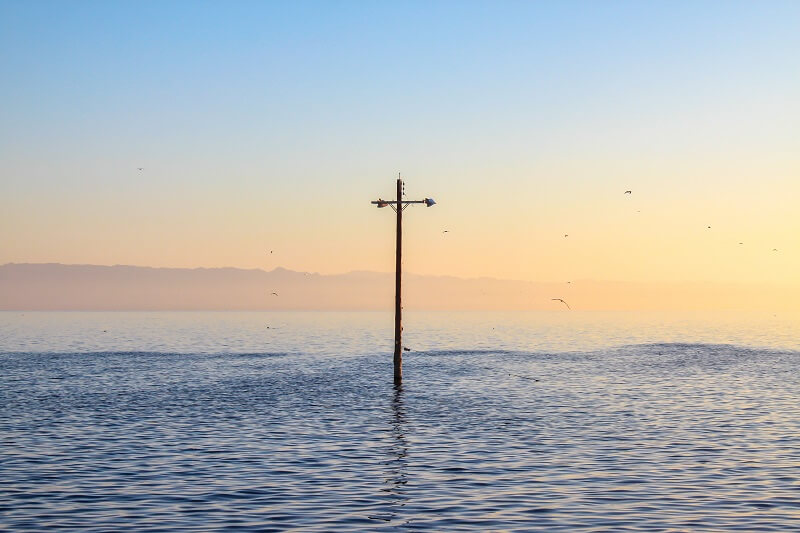
Getting Rid of Standing Water in Your Yard
Do you have one or more areas in your yard that hold water after a rainfall? This is a common problem, and sometimes difficult to solve. Over the years I’ve talked with dozens of people trying to battle this problem, and on several occasions I have been hired to solve the problem. So what can be done?
Too often people come to me asking what kind of a tree, or what kind of shrubs can be planted in a wet area to dry it up. This is the wrong approach. Most plants, and I mean almost all plants are not going to survive in an area where the soil is soggy for extended periods of time. The roots need to breathe, and planting a tree or shrub in a water area will kill it.
Another common approach is to try and fill the area with topsoil. Depending on a variety of variables, this can work, but many times adding additional soil to a wet area will only shift the water to another area just a few feet away.
If you are lucky enough to have some natural fall to your property, or a drainage ditch nearby, this problem is easy enough to solve. If you happen to live in an area that was developed over the past few years, there might even be a system to remove storm water nearby. In many new home developments I’ve seen stormwater catch basins already installed in backyards. Trust me, this is a good thing. There is nothing worse than having a soggy yard all the time.
If you are fortunate to have some fall to your yard, or a stormwater system that you can drain water into, this problem is easy to solve. Make sure you check with your local officials before you do anything at all with a storm drain.
All you have to do is go to your local building supply center and buy some 4” perforated plastic drain pipe. The best kind for this purpose is the flexible kind that comes in 100’ rolls. This type of drain pipe has small slits all around the pipe. These slits allow water to enter the pipe so it can be carried away.
Just dig a trench from the center of the low area you are trying to drain, to the point that you intend to drain it to. Using a simple line level you can set up a string over top of the trench to make sure that your pipe runs downhill all the way. A line level is a very small level that is designed to attach to a string. Any hardware stores sells them for just a couple of dollars. Set the string up so it is level, then measure from the string to the bottom of your trench to make sure you have constant fall. You should have 6” fall for every 100’ of pipe.
The highest point is going to be the area that you are trying to drain, so you only want your pipe deep enough at this point so it can be covered with soil. Once the trench is dug just lay the pipe in. At the highest end of the pipe you’ll need to insert a strainer into the end of the pipe to keep soil from entering the pipe. Cover the pipe with some washed stone, and then backfill the trench with soil. The washed stone creates a void around the pipe so that the water can find its way into the pipe.
Washed stone is usually inexpensive stone that has been washed so it is clean and free of mud. The only part of the pipe that needs to be exposed is the low end, where the water exits the pipe. Do not put a strainer in that end.
If you do not have anywhere that you can drain the water to, you still might be able to do something. But first consider what is happening, and why the water is standing where it is. Even if you have well drained soil, water cannot soak in fast enough during periods of heavy rain, and it runs across the top of the ground and eventually finds the lowest point, and either leaves the property, or gets trapped.
If you have well drained soil, the trapped water usually soaks in. If you have heavy clay soil, the water lays there, and the soil underneath becomes very compacted, and the problem compounds itself. The more water that stands, the worse the drainage gets.
What I have done in areas like this, where there is standing water, but nowhere to drain it to, is to install a French drain system that actually carries the water away from the low area, and allows it to seep into the ground over a larger distance, where the soil is not quite so compacted. To install this French drain system you do everything exactly as explained above, except instead of draining the water to a lower area, you can send it in any direction you like. Even in the direction from which it came, which is uphill.
When installing this type of system, it’s a good idea to dig a number of shorter trenches, all heading away from the area where the water stands. Using the line level, make sure your trenches fall away from their point of origin so once the water enters the pipes it will flow away from the wet spot. What is going to happen is that during times of heavy rain the low area is still going to trap water, but much of that water is going to seep into the drain pipes and eventually leach into the soil under each trench.
Because this soil has not been compacted by the standing water and the baking sun, it will accept the water. It won’t happen nearly as fast as if you could just drain the water to a ditch, but at least you will have a mechanism in place that will eventually disperse the water back into the soil. It’s a lot easier to leach 200 gallons of water into a series of trenches that total 100 lineal feet, than it is to expect that water to leach into a 10’ by 10’ area that is hard and compact.
To see the rental equipment in Milton or Crestview, FL click here
